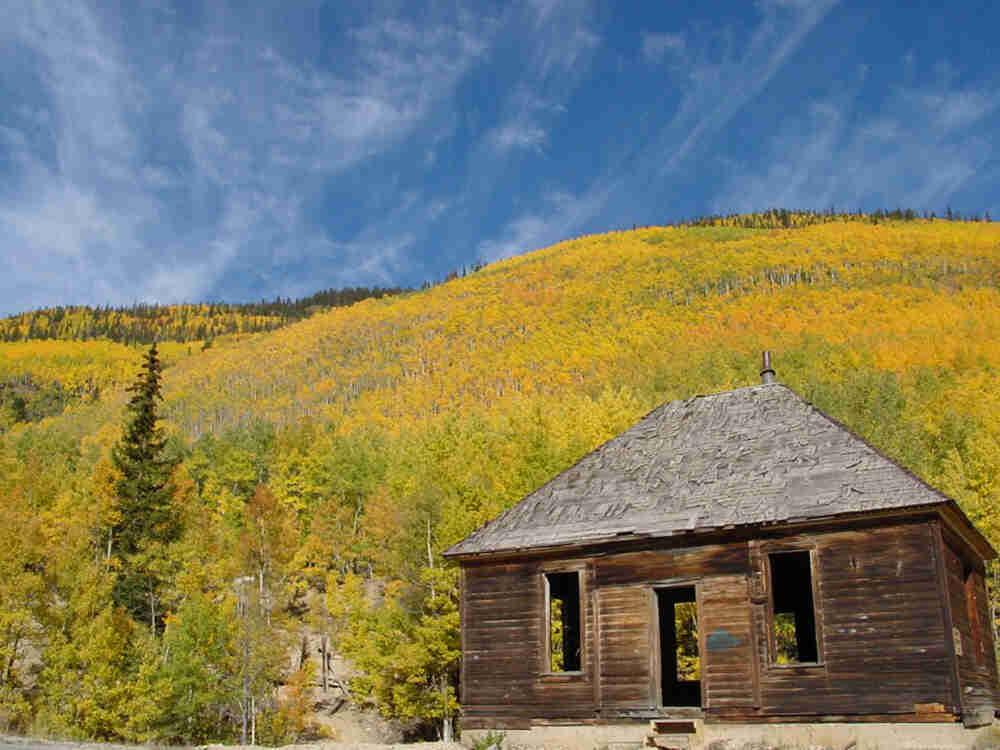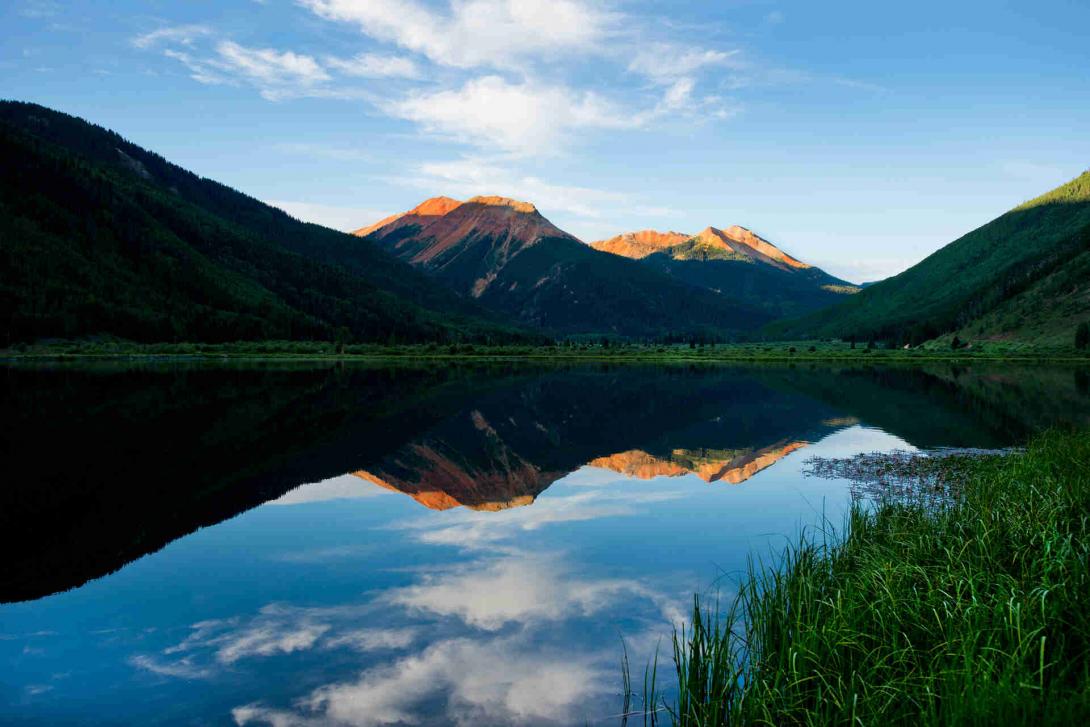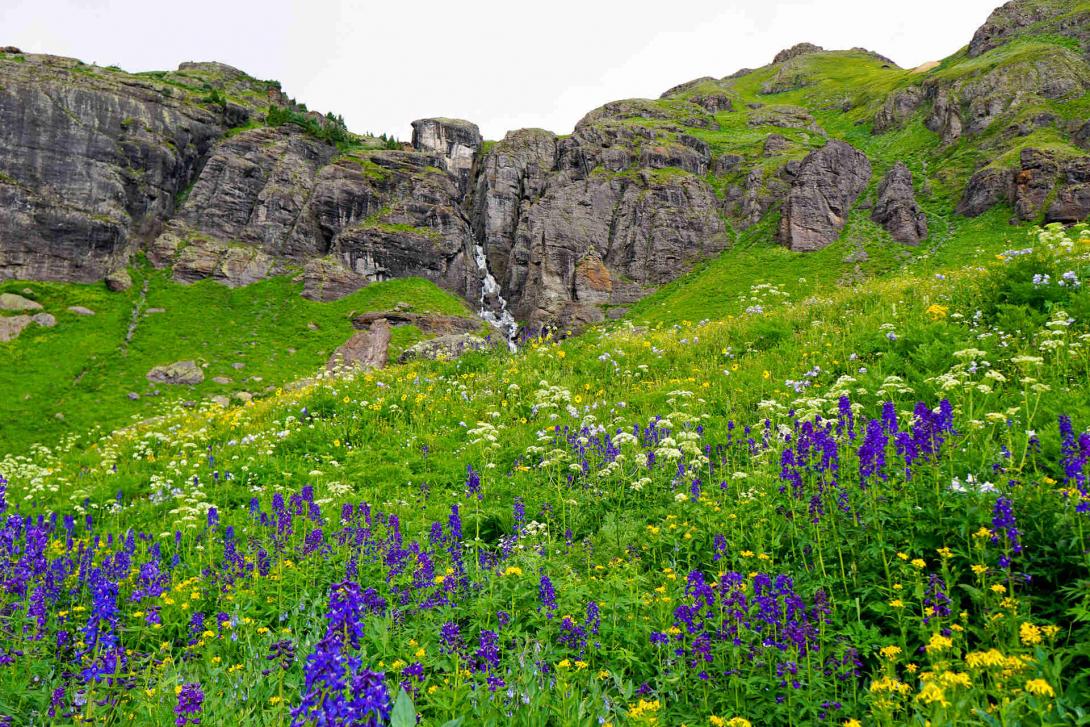San Juan Mountains
Full Article
The San Juan Mountains are the largest mountain range by area in the Centennial State, spanning thirteen counties in southwestern Colorado. In addition to being the home of the Ute Indians for hundreds of years, the mountains intrigued Spaniards, lured the prospectors of the Colorado Gold Rush, and attracted thousands of vacationers and seekers of outdoor adventure. Today the mountains are home to many historic mining towns that are now popular tourist destinations, including Telluride, Silverton, Ouray, and Pagosa Springs.
Formation and Features
Part of the Southern Rockies, the San Juan Mountains were created as two enormous continental plates slammed into one another, folding and faulting the earth’s crust. Volcanic activity associated with the tectonic mountain-building process produced rich mineral veins—the silver and gold deposits that drew miners to the region in the 1860s and 1870s. Glaciers carved the range’s steep mountainsides and U-shaped canyons, such as the iconic box canyon that surrounds Telluride. The San Juans contain some of the highest and most jagged summits in the continental United States, with twenty-eight peaks above 9,000 feet and thirteen Fourteeners. Uncompahgre Peak is the highest, measuring 14,309 feet.
The San Juan River is a significant tributary of the Colorado River and has its source in the southern slopes of the San Juan Mountains. Notable tributaries of the San Juan River include the Animas, Piedra, and La Plata Rivers. Two of Colorado’s four subspecies of native cutthroat trout inhabit the mountain streams and rivers of the San Juans: the Rio Grande cutthroat trout (Salmo clarki virginalis) and the Colorado River cutthroat trout (Salmo clarki pleuriticus). A variety of mammals also inhabit the thickly forested mountain slopes, including elk, bighorn sheep, lynx, black bear, and mountain lion, among others.
Human History
The nomadic Ute people lived in the San Juans for more than 500 years, following game up to the high country during the summer and retreating to lower elevations—such as the area near present-day Durango—during the winter. To supplement diets of elk, mule deer, jackrabbit, and buffalo, the Utes gathered a wide assortment of berries and roots, including the versatile yucca root. On their seasonal migration routes, the Utes trod paths that were later used by Spanish explorers and American miners and road builders.
All that was necessary for the Utes’ survival lay on top of the earth, so they did not bother to mine the San Juans. But locating minerals was a primary objective of multiple Spanish expeditions in the eighteenth century. Guided by Utes, Spanish parties repeatedly searched the mountains for silver but failed to find any significant deposits. By the time of Juan María de Rivera’s expedition of 1765, many of the Spanish place-names, such as the names of the mountains and their rivers, were already in common use. In the 1820s trappers and mountain men ventured into the San Juan Mountains for another natural resource—beavers. According to later reports, many trappers, including the famous Kit Carson, insisted that the southern ranges were full of gold, silver, and other valuable minerals.
With some of Colorado’s highest and most rugged peaks, the San Juans challenged anyone who sought to wrest mineral riches from their granite-ribbed depths. By the time of the Colorado Gold Rush of 1858–59, the legends and stories of the San Juans had traveled far, hard to pin down but tantalizing to ponder. The San Juans lay weeks of mountainous travel away from Denver, a trip that seemed unnecessary in light of the great strikes along the Front Range in those years. Nevertheless, in 1860 the prospector Charles Baker made the trip. In the western San Juans, in a park that now bears his name and where the town of Silverton now sits, Baker found gold. It seemed rumor had finally turned to reality in the San Juans.
Gold Rush
The Baker party reached the San Juans in August 1860. In the Rocky Mountain News later that year, one member described the mountains as “the highest, roughest, broadest and most abrupt of all the ranges.” He concluded the article by exulting that in the San Juans, “the metalliferous development of this region, if not of the North American continent, reaches its culminating point.” This news spurred a stampede of prospectors toward the San Juans in 1861.
The initial rush came by way of New Mexico and up the Animas River on Baker’s toll road, which passed through Animas City. This first rush, however, was fleeting for several reasons. For one, Baker had found placer gold—small pieces of gold lying on the surface, mostly in streambeds—and not nearly enough as he thought he did. Second, resistance from Utes made it virtually impossible to occupy the area year-round. Finally, the region’s climate, elevation, and isolation were not conducive to months of prospecting. Hundreds of miners left Baker’s Park disappointed, grumbling about a “San Juan Humbug.” Rumors of fabulous wealth in the San Juan Mountains faded for a time, but the stories still beckoned, and miners’ appetites were whetted. Prospectors again moved into the area after the Civil War (1861–65).
One of the early prospectors, John Moss, focused his attention on La Plata Canyon. Moss negotiated a treaty with the Utes for the land and brought in California capital to underwrite his mining. Parrott City, at the mouth of the canyon, served as his headquarters. Isolation, scant profits, and Moss’s own eccentricity doomed his effort. His was the first, but not the last, of the attempts to find the mother lode in that canyon’s depth.
Among the first results of the renewed interest in the San Juans was conflict with the Utes, who had been guaranteed the land in the Treaty of 1868. Unlike Moss, most San Juan miners did not stop to negotiate with the Utes, simply assuming the land would be theirs. The federal government came under pressure from both sides and even ordered the miners to leave, but they refused. Instead of forcing them out, the government negotiated the Brunot Agreement in September 1873, in which the Utes ceded 3.5 million acres in the heart of the San Juans. In return, the Utes were to receive $25,000 annually and retain the right to hunt on the ceded land, as long as game lasted and peace was maintained.
However, instead of peace, the years that followed saw increased tension and violence between Utes and whites in southwest Colorado and across the Western Slope. In 1880, following the Meeker Incident of 1879, most of the remaining San Juan Ute population was forced onto the Southern Ute Reservation in southern Colorado. As was typical of mining in the west, the boom brought Indian occupation of the San Juans to a quick and decisive end.
White settlement and development of the San Juans continued. The towns of Silverton, Howardsville, and Eureka took root to serve the miners who worked the surrounding mountains. Nestled among the high peaks, Animas Forks and Mineral Point anticipated a bonanza from nearby mines. Silverton, the largest high-country town, boasted a population of 1,000 by 1880, while farther north Ouray and Telluride struggled for their share of business and prominence.
For the miners, the 1870s was a decade of waiting—waiting for investors, for mills, and for smelters to work the ores profitably, and most of all, for the railroad to provide efficient transportation. By the mid- to late 1870s Silverton had functioning smelters, but lack of finances and engineering problems had delayed the arrival of the Iron Horse to the San Juans. By 1880, however, William Jackson Palmer’s Denver & Rio Grande Railroad (D&RG) was on its way. In September the first survey stake for the new town of Durango was driven, and in July 1882 the first train steamed into Silverton from Durango.
The arrival of the D&RG inaugurated two decades of railroad building within the district and initiated the long-awaited San Juan bonanza. Carloads of gold and silver steamed from the mountains to the smelter in Durango, where copper, lead, and zinc were recovered as byproducts and coal was mined to fuel mining and railroad operations. Although the mountains were rich in all kinds of metals, silver reigned supreme in the San Juans. In 1891, for instance, miners in San Juan County extracted more than $761,000 in silver compared to $192,000 in gold.
In 1893, however, the federal government drastically reduced its silver purchases, plunging silver mines in the San Juans and throughout Colorado into a devastating depression from which they never recovered. The price of silver had been declining for years as production increased, but the Panic of 1893 did more than close silver mines; it also brought an end to the era of the lone prospector who selected a rocky outcropping, filed a claim, and mined his fortune. Mining had become big business and was dominated by large corporations. In San Juan County, the deep pockets of large mining companies helped the county’s mines survive the depression and actually increase silver and gold production in the years that followed. However, these companies most often brought in huge profits at the expense of their employees, which led to serious and often violent labor disputes.
Labor Strife
To try to improve their bargaining position in this new industrial world, many miners joined the Western Federation of Miners, a union despised by companies and mine management. The San Juans became one of the union bastions of the Rocky Mountains. Labor tension increased, and finally, in 1903–4, Telluride and Cripple Creek, a rich gold district on the Front Range, exploded in turmoil. Union miners lobbied for better pay, shorter work days, and safer working conditions. Governor James Peabody’s deployment of National Guard companies to break the strikes on behalf of mine owners created lasting grudges, especially since the miners had to return to work with no changes in pay or work regimen. In Telluride, mine boss–turned–National Guard Captain Bulkeley Wells declared martial law and illegally deported miners to neighboring Ouray County. To keep the deportees out, Wells built a machine gun nest atop Imogene Pass, the only way back in to San Miguel County from the east.
Today
In 1913 the Silverton Commercial Club promoted the San Juans as a place for recreation and tourism, indicating that the era of striking it rich in minerals had come to an end. The San Juans had been conquered and developed. San Juan mining operations made pioneering advances in the use of tramways to transport ore, in the industrial use of electricity, and in various new types of equipment. Mining camps had been born, prospered, and died.
While mining no longer dominates the economy in southwestern Colorado, its legacy continues to draw thousands of eager tourists to the region annually. Extant mining structures—such as mining smelters, boilers, and mills, as well as boardinghouses and defunct saloons—still pepper the landscape. For example, the Shenandoah Dives Mill complex southeast of Silverton dates to 1929 and provides a glimpse into the area’s historic mining past via a museum and rehabilitated mine structures. The Smuggler-Union Hydroelectric Plant, built in 1907 atop a waterfall near Telluride to supply power to Bulkeley Wells’s Smuggler-Union mine, was restored in the late 1980s and still produces electricity today. Remains of Fort Peabody, the machine-gun post used to discourage deported miners’ reentry into San Miguel County, are still visible atop Imogene Pass east of Telluride.
While historic mining spurred the development of the region and is still a major tourist attraction in the San Juans, it left a devastating environmental legacy. Acid mine drainage occurs when subterranean rock is exposed to oxygen and groundwater. Sulfides in the metal-containing rock break down into sulfuric acid, which then dissolves the metals and allows them to flow into nearby water sources. This yellow-orange metallic slurry has entered the Animas River on multiple occasions since the mining period, threatening wildlife and drinking water supplies. The most recent incident occurred in August 2015, when workers for the federal Environmental Protection Agency (EPA) accidentally released 3 million gallons of contaminated wastewater from the Gold King Mine into the Animas. San Juan County officials had previously been reluctant to have the county’s dozens of abandoned mines declared an EPA Superfund site—a high-priority cleanup site—but after the Gold King blowout they reconsidered, voting unanimously in February 2016 to request Superfund site designation.
In addition to their proud but fraught mining legacy, the San Juan Mountains’ rugged peaks, verdant forests, and whitewater rivers also provide a variety of recreational opportunities, from hiking and backpacking, kayaking and mountain biking, to snowshoeing and skiing. In 1996 the US Secretary of Transportation designated the San Juan Skyway as an All-American Road. The 233-mile highway loop, part of the Colorado Historic and Scenic Byway, provides tourists with stunning views of the San Juans’ 14,000-foot peaks as it carries them through Durango, Silverton, and other archetypal western towns. The skiing hamlet of Telluride—also known for film, bluegrass, and jazz festivals—and the mountain retreat of Ouray are popular stops along the route. The road also takes visitors to Mesa Verde National Park, one of the most popular national parks in the United States. Revered by the Ute Indians for centuries and a key part of Colorado’s economic and environmental story, the picturesque landscape of the San Juan Mountains continues to impress locals and tourists alike.
Adapted from Duane A. Smith, “The Miners: ‘They Builded Better Than They Knew,’” in The Western San Juan Mountains: Their Geology, Ecology, and Human History, ed. Rob Blair (Boulder: University Press of Colorado, 1996).











































